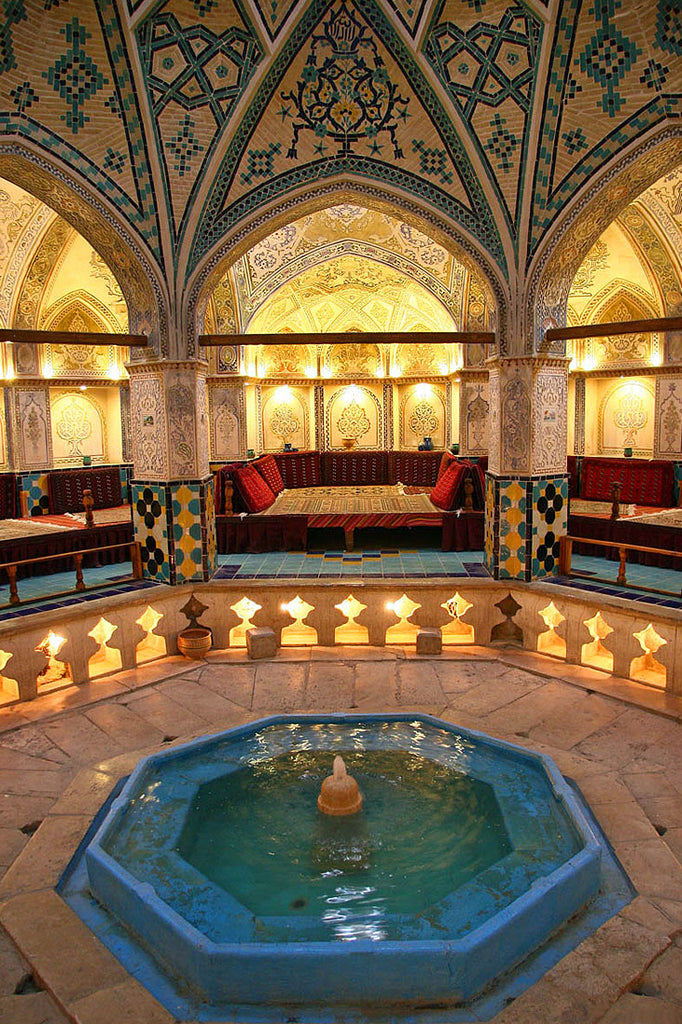
Our modern culture places a great deal of emphasis on the importance of relaxing, rejuvenating and detoxing. We visit spas, go to the gym, meditate and do yoga to cleanse our bodies of toxins, and our minds of stress and anxiety. However modern this concept may seem, it has its roots in ancient traditions, from Greek, Roman, Persian and Arabic cultures. In particular the traditional Turkish hammams.
Traditional Turkish Hammam Baths
It could be said that the roots of the Turkish bath come from Anatolia, the birthplace of minted coins. Following the Arabic conquest of Alexandria in 671, the Arabic peoples discovered the Roman baths built in the great cities, and during the following centuries, Hellenised Roman and Anatolian Turkish cultures were merged to create the traditional Turkish hammam baths.
The Turkish hammam baths contain three rooms: the ‘hararet’ (hot room), ‘tepidarium’ (intermediate room) and the ‘soğukluk’ (the cooling down room). When experiencing a Turkish bath, the bather begins in the warm room, where they relax in hot dry air, and are encouraged to perspire the toxins out of their system. From here, the bather is massaged, washed and scrubbed by an attendant in the hot room, before retiring to the cool room to relax, drink tea and perhaps take a nap.
Turkish baths were traditionally masculine, with woman often being forbidden from using the hammam baths except following pregnancy or illness. Even today, the hammam baths are always segregated, as bathers are typically wear only a traditional hammam towel.
Traditional Hammam Towels
These towels were an integral part of the hammam experience from the beginning, and their increasing popularity has not compromised their authenticity. Also known as a ‘peshtemal’, they are one of the features of Turkish baths that has survived the centuries, and are as essential to the experience now as they were then.
The traditional hammam towel, or peshtemal, is woven entirely of cotton on looms in Turkey, with the tassels on each end tied by hand. Historically, the colours were especially significant, with different colours, patterns and designs denoting different regions and local areas of the country.
The uses of the traditional hammam towel are almost unlimited. Firstly of course, they were designed for preserving the modesty in the hammam, to be worn tied around the waist. Particularly in the hararet, the air is extremely hot and steamy, and so it is essential that these towels be lightweight, quick drying, and absorbent.
The story goes that the ladies of the Ottoman hammam demanded a newer design of towel with extra thickness as an alternative to the conventional, flat-woven traditional hammam towel. An extra layer of warp was added to the weaving process, and the modern looped towel we’re all familiar with was created. However, the versatile features, cultural richness and beauty of the original peshtemal have ensured that these traditional hammam towels have remained popular, and are currently enjoying a renaissance.
Why are traditional hammam towels making a come back?
A traditional hammam towel weighs approximately a third of the everyday towel, but loses none of its absorbency. This makes it extremely popular as a modern-day alternative for travel and gym use. In addition to this, the cotton that is used has a property that causes each wash to make the material softer, stronger and more absorbent.
The lightweight and visually beautiful nature of the traditional hammam towel allows it to be used as a stunning throw or tablecloth, sat on to form a comfortable picnic blanket, or tied around the body as a sarong.
Furthermore, traditional hammam towels are far more eco-friendly than the usual everyday bath or beach towel. Less water is needed to wash them, they dry far more quickly, and the lower weight allows them to be transported far more easily.
So treat yourself to a traditional hammam towel, or peshtemal, and join thousands of years of Turkish bathing traditions.

